Past Residents
Lord Alexander Leitch (20th October 1947 – 5th October 2024)
Alexander "Sandy" Leitch lived in Kington St Michael in the 1980s/90s, at The Old Rectory. He and his then-wife, Valerie, would open up the gardens to be used for the church fête.
He became a life peer as Baron Leitch of Oakley, in Fife, on 7th June 2004, having demonstrated his commitment to public service as chair of the National Employment Panel for over six years. To find out more about Sandy, please visit Wikpedia.
Anita Periere (22nd October 1916 - 3rd July 2019)
"Ethel Anita Pereire, described by The Independent newspaper (UK) as “the doyenne of French garden writers”, died in Hartsdale, New York, on July 3rd at the age of 102. While her writings on gardens and plants were prolific, her interests and achievements ranged across a wider and astonishingly varied range of activities.
Anita was born in London on October 22nd 1916, to Dora Blaustein and Jacques Kartun, a Belgian diamond merchant. Deciding quite early that Ethel was not a name she wished to own, she adopted Anita. Her younger brother, Derek Kartun, went on to become a member of the Communist Party of Britain (briefly), a journalist with The Daily Worker, a writer of espionage thrillers, and CEO and chairman of Staflex, a major company manufacturing clothing for the mass-market.
Anita’s father encountered severe business problems, said to have involved an open safe, a dishonest partner, and some jewels once belonging to the Russian imperial family, forcing the family to move from a life of luxury in London to a modest one in Paris. Detesting school, Anita left at the age of 15 to become, through an acquaintance of her mother, an assistant to the buyer of French fashion at Macy’s Department Store in New York.
At 17, she met Francois Pereire, descendant of a 19th-century banking family, and they immediately fell in love, a commitment that was to last the rest of their lives. Francois had met the German chancellor, Adolph Hitler, in 1936 and having read Mein Kampf, he rapidly came to understand what the fate of Jews was likely to be. When he and Anita married in 1937 and went to Morocco on their honeymoon, Francois took a position in Rabat with the Royal Bank of Morocco. With war declared, he was called up by the French army while Anita remained. Demobilised, he and Anita moved to Casablanca where German troops in North Africa presented a constant danger.
After the war in 1945, they returned to France with their three small daughters, Laure, Claudia and Annik, all born in Morocco. In 1950, son Marc was born in Paris.
When French women gained the right to vote in 1944, the legendary Helene Lazareff founded the year following a weekly women’s magazine, Elle, devoted to the new, liberated, post-war French woman. Anita joined as her assistant in 1952, finding a ready listener and willing promoter of her ideas. With three teenage girls of her own, she identified a new market and introduced a new segment to the magazine, “Nous les Jeunes Filles”, or “Us Girls”. She wrote an advice column. She introduced trends from the US, like jeans and T-shirts, and travelled there often. Brigitte Bardot modelled a sweater for her. She began to publish novels and books of advice for teenaged girls.
She lived a glamorous life, jet-setting, meeting politicians, intellectuals and film stars.
When, in 1957, Francois founded the France-Israel Chamber of Commerce she travelled to Israel with him, staying on a kibbutz with David Ben-Gurion and his wife, Paula Munweis. She went on an archaeological dig with Moshe Dayan, Israel’s minister of defence. She learnt bullfighting from the legendary Luis Miguel Dominguin. Invited to Buckingham Palace, Queen Elizabeth asked whether she wrote in French or in English, to which Anita replied, “In French”. “How clever,” said the Queen.
In 1972, she discovered the 18th-century Cistercian Abbaye Notre Dame de l’Eau near Chartres was for sale. Here, her latent talent for landscape design came to the fore. The abbey grounds were extensive and virtually untouched. Starting from scratch, within 18 month she had created a magnificent garden which became one of the first private gardens in France open to the public. From this she developed rapidly a reputation for distinctiveness, innovation and charm. Potential clients sought her out.
Over the next 20 years she designed many gardens in France, England, Greece, the US, the Caribbean. Despite being Jewish and with a husband so closely allied to Israel, King Hussein of Jordan employed her to design a garden for the royal residential complex in Amman and then another on the banks of the River Jordan. She attacked a singularly difficult stony garden site in the Virgin Islands with dynamite to create a large pool but also resorted to primitive technology used by the makers of Stonehenge to break up boulders, a practice that involved starting fires to heat the stones and then dousing them with cold water.
Anita knew how to address a growing market insatiable for ideas and information. Her garden design practice led to a regular program on French TV, gardening columns for Le Figaro Magazine and France Soir, and 23 books published in French and English. The first of these appeared in 1984, Private Gardens of France, with Gabrielle Van Zuylen, who also became a renowned garden writer. In 1985, it won the prestigious Prix Lange awarded by the Academie Francaise. She persuaded her publishers to produce small books as well that could slip easily into the pockets of gardening overalls.
In 1990, Francois died after a long illness, and Anita found she could no longer live in France. She had designed a garden at Woburn Abbey in England and at a lunch there she learnt that a 17th-century Cistercian Priory was for sale in Kington St Michael just outside Chippenham, Wiltshire, with several hectares of ground ripe for a garden. Anita bought it and moved in.
The gardens quickly took shape: a formal French garden, an English garden, a water garden, a rose garden, and a shrubbery walk with an ancient “ha-ha”. A visit to the Priory at Kington St Michael became a must for garden-lovers in England and abroad. In 1996, the “Anita Pereire” rose was named after her, a fitting tribute since the famous and wonderfully fragrant “Mme Isaac Pereire” rose had been named after Francois’ great-grandmother, Fanny Pereire. Anita wrote incessantly, producing encyclopedias on flowers, house plants and gardening for each of Cassell’s, Prentice-Hall, and Ward Lock, while Hachette continued to publish her work in France. Gardens for the 21st Century, which appeared in 1999, captured the public’s enthusiasm and expectations about the new century.
Anita’s last book appeared when she was 96, in 2012, a guide to garden plants for Hachette. France’s national library lists 42 separate titles against her name, starting in 1955.
Suddenly, in 2014, deciding she could no longer manage the Priory, she moved to New York where she lived quietly with her daughter Annik and family close by. On her 100th birthday in 2016, the whole extended family flew to New York from England, France, Greece, and Singapore, to celebrate her life. A fall in 2018 was a setback from which she never really recovered. Anita Pereire leaves her daughters, Laure and Annik, eight grandchildren, and 13 great-grandchildren. Her daughter, Claudia, died in 1994 and her son, Marc, in 2015."
This tribute was written by historian Helen Davies (Melbourne), a friend of Anita, and Annik de Lacaze (New York), Anita’s youngest daughter. [2018]
Jeremy Corbyn MP
The Right Honorable Jeremy Corbyn MP was born on 26th May 1949, in Chippenham, and lived in Hillside House, Kington St Michael until the age of seven.
Robin Duckett (1st June 1935 - 16th June 2023)
Well, we could hardly believe it, but on Saturday 25th February 2006 a true villager left us for pastures new. We bade a fond farewell to Robbie Duckett and his wife Barbara. Robbie is one of the few people who was born in the village, and apart from when he was away for his National Service, had lived here all his life (over 70 years!), seeing many changes along the way. Robbie was born in Pound Cottage, 42 KSM, on June 1st, 1935 and was the fourth generation of his family to be born in the village (his birth name was actually Lawrence!). He went to the village school, which is now the village hall, until he was 15 and then he worked for Mr Tayler at Manor Farm until he was called up for National Service in 1953, when he joined the army and served in Egypt and Cyprus.
On leaving the army he worked for a local building company, Hawkins & Hull, as a lorry driver. He went on to become a builder and by the time the firm closed in 1985 he was one of the Directors. He then continued as a self-employed builder until he retired (?!) in 2000.
Robbie was elected to the Committee of KSM CIU Club in 1962 and was Chairman for many years and was honoured as a Life Member. Robbie and Barbara were married on 30th March 1963 and their first home was in Folly Row until they moved to 45 Kington St Michael, where they lived until leaving the village. They have two grown-up children, Paul and Karen, who both live locally.
In 1973 Robbie was elected onto the Parish Council, and had recently held the position of Chairperson. He was involved with many village projects, including the acquisions of the recreation field (where there is now a bench and rowan tree in his memory), the village hall and, in the early 2000s, with the opening of the new Post Office and shop. It is true to say that Kington St Michael truly benefited from his local knowledge and the time he gave to the parish.
|
|
|
Robbie (left), at the signing of the lease for the Post Office in 2004,
with Howard Greenman (sub-Postmaster) and Mrs Kathy Kirby, the then Chairperson of the Village Hall Management Committee. |
Bertha Gainey and Ivy Cottage
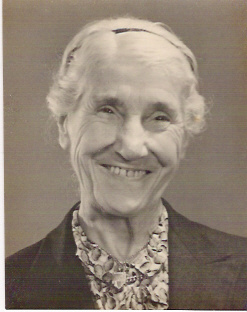
|
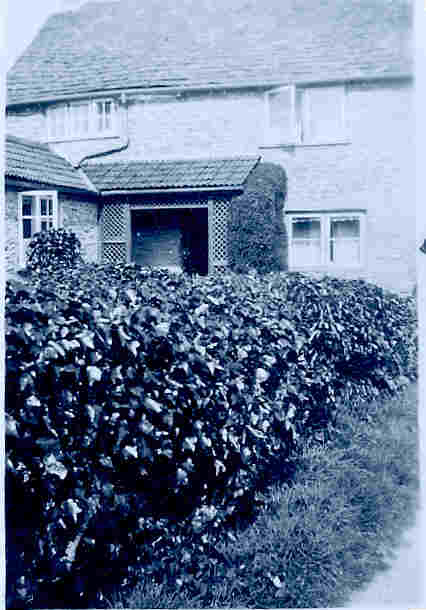
|
|
Bertha Gainey Ivy Cottage in the 1920s
(Photos courtesy of Margaret Lawrie) |
Ivy Cottage, 4 KSM used to belong to Margaret Lawrie's grandfather, William Gainey (the 4th son of Mr & Mrs Jones Gainey). The Gainey's were an old KSM family. William married Bertha (formerly Bertha Gale, daughter of the late Mr & Mrs John Gale) also of KSM.
Many thanks to Margaret for providing the following information:
"Ivy Cottage was a ramshackled cottage when my Grandfather purchased it for £76 c1911. He had to go to the Squire at Kington Manor to speak for him to buy the cottage. I understand that he was the first person to buy a property in the village (apart from the wealthy who already had homes there). He restored it using the original materials and roof tiles but unfortunately c1940 the rain started to come in and the roof was replaced with modern tiles. In c1932 he was the first person in the village to have electricity. From memory I believe there is a photo of my Grandfather with his bicycle. He was the first person in the village to have a bike and was very proud of it."
Mabel Jane Goodchild (neé Coleman)
Mabel was born in Kington St Michael in 1888. She wrote a history of her life, which was kindly passed to us by Mr Newton Tainsh, who discovered it in the effects of his late wife, Tyrol-June. It had been sent to her by Marion Adams of Etobikle, Ontario, Canada, who was Mabel's daughter.
To read Mabel's fascinating history please click here.
Herbert Prodgers (1835-1917), Justice of the Peace.
Herbert, the fourth child and younger son of Rev Edwin
and Caroline Prodgers (née Blades), was born at Clarence Lodge in Brixton in
1835. His baptism at St Matthew Brixton was conducted by his father on 3rd
August. Like his brother he went to Eton and Oxford but he aspired to be the
epitome of the country squire and succeeded brilliantly. More information about the Prodgers family and lineage can be round on the Ayot St Peter website.
In 1860 he married Emily Sibella Phillpotts (1835-1918) in Cornwall. In December 1861 his father died and he no
doubt came into a substantial inheritance. This encouraged him to buy the manor of
Kington St Michael, near Chippenham in Wiltshire. In 1863 his mother died and more money would
have come his way. In that year he demolished the old manor house and built a
magnificent replacement. He also had land in Scotland – presumably an estate
suited to hunting, shooting and fishing.
Herbert died in April 1917 and Emily almost exactly a year later. Herbert left
an estate of £82,681 and Emily’s amounted to £2,381.
There were seven children born at Kington St Michael between 1861
and 1876 – Cecil, Ronald, Harold, Charles, Gwendoline, Rhoda and Greville.
Squire Prodgers also gave the village its school and schoolhouse, which was used
until the late 1970s when the current school was built.
Village folklore tells that Squire Prodgers has a diagreement with the then vicar and so built the gatehouse to Kington Manor in order that he and his family could continue to listen to church services without having to attend the church!
A print of Squire Prdgers, dated 1862, is held at the National Portrait Gallery (view here).More information is available on the main History page.
John Aubrey & John BrittonPlease click here to read about these famous sons of Kington St Michael.
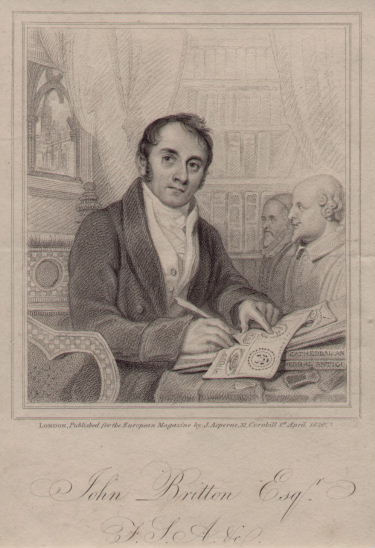 |
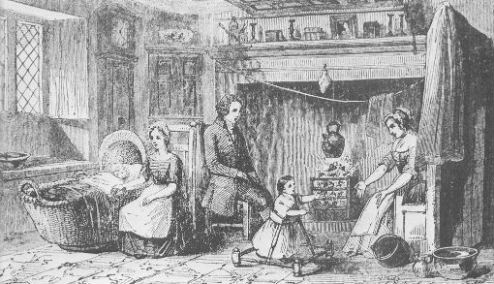 |
|
John Britton and John Britton's Cottage interior in 1777
- from a book by David Burnett called A Wiltshire Portrait 1568-1856. (With thanks to Matt Bridger) |
John Britton's cottage stood where the old village hall now stands (next to the 'phone box). John Britton was born in Kington St Michael in 1777. The single downstairs room served as a hall, parlour and kitchen. Britton’s father was the village baker and shopkeeper, and Britton was later to explain his rise from such humble beginnings as proof “of what may be affected by zeal and industry with moderate talents and without academic learning.”
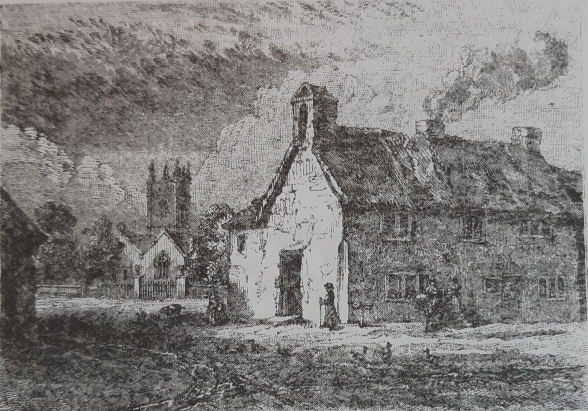
John Britton's cottage, from The History of Wiltshire by Rev. J E Jackson
Britton was instrumental in the founding of the Wiltshire Topographical Society (now The Wiltshire Archaeological and Natural History Society). He was also the author of The Beauties of Wiltshire and The History and Antiquities of the Cathedral Church of Salisbury.
From 1820-1857 Britton lived at Burton Cottage, 17 Burton Street, London - please click here to learn about his life there.
Britton is buried in West Norwood Cemetery, London, where his monument, a vertical 10' slab of brown granite, was designed to be as permanent as Stonehenge. It is listed as Grade II*.
Britton Street in Clerkenwell (formerly known as Red Lion Street) is named after him.
Nicholas Snell MP (d. 1577)
John Snell MP (1537-87)
Owners of Kington St Michael and Member of Parliament, the Snells were prominent on the Wiltshire-Somerset border.
Please click here to learn more about Nicholas and click here to learn more about John.
Links with Francis Kilvert, the Diarist
The mother of Francis Kilvert was a member of the Snell family who had bought the manor of Kington St Michael at the Dissolution of the monasteries. Kilvert himself was a close friend of Charles Awdry, the vicar of Kington St Michael, and he deputised for him in 1864-5, living in the village for several months.
In the years 1874 and 1875 Kilvert made several visits to the village which he recorded in his diaries: ‘Around lay the rich undulating country, the emerald meadows in their setting of golden cornfields, and below nestled the King’s town, the home of my forefathers with the grey Church tower embosomed amongst its limes, and the long village street climbing the gentle slope beyond.’ [15th August 1875] He also relates that when the church bells were rung people in Kington Langley used to say “A hen has laid an egg at Kington”. This was a saying, which indicated the local supposition that Kington inhabitants were too ready to ring their church bells without reason.
Bibliography: Kilvert’s Diary edited by William Plomer. Various editions
www.thekilvertsociety.org.uk